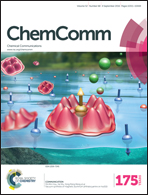Electrocatalytic water oxidation by a macrocyclic Cu(ii) complex in neutral phosphate buffer†
Abstract
A single-site copper complex, [Cu(TMC)(H2O)](NO3)2 (1, TMC = 1,4,8,11-tetramethyl-1,4,8,11-tetraazacyclotetradecane), was found to be the most active copper-based catalyst towards electrocatalytic water oxidation in neutral aqueous solution. Complex 1 leads to a cathodic shift of approximately 200 mV in potential to reach a current density of 1 mA cm−2 in comparison with that of the previously reported dinuclear copper complex under the same conditions. Upon immobilization of complex 1 on carbon cloth, it shows greatly improved activity than other copper-based WOCs including CuOx and Cu2+.


 Please wait while we load your content...
Please wait while we load your content...